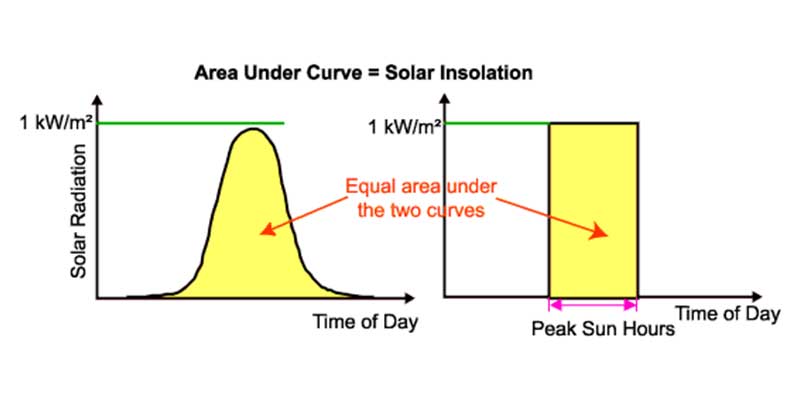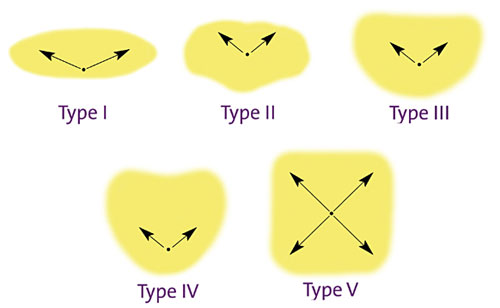In the course of designing an off-grid solar street lighting system, you’re often faced with an initial challenge of factoring the Peak Sun Hours of your location to experience maximum energy from your solar PV system.
If you’re not a PV technical personnel, understanding the peak sun hours and factoring it could be a difficult task.
But,
Not to worry, in this post we’ve made the process as simple as possible for you to understand and apply the same to your PV installation.
To start,
Let us take a clear look at the term itself.
What is Peak Sun Hours?
In simple terms,
Peak Sun Hours is the number of hours in a day when the Sun is at its maximum radiation.
The value of PSH varies per location, this is due to some certain factors that will be discussed shortly.
Before then, let’s break down the technicalities; because there’s more to the definition.
Average radiation from the sun measured on the surface of the earth during a clear day or noon is about 1000W/m2. (This value is standard for all PV tests & measurements.)
The number of hours in a day that a location experiences this value of radiation is called Peak Sun Hours.
1 Sun Hour is equivalent to 1000 W/m2 of the sun’s radiation collected in 1 hour.
3 Sun Hours is equivalent to 1000 W/m2 of the sun’s radiation collected in 3 hours.
The unit of measurement is therefore kWh/m2. It is also expressed as kWh/m2 day, this refers to the total Peak Sun Hours in a day.
As stated earlier,
Based on your location, there are couple of factors that affect the value of the Peak Sun Hours.
What are they?
Factors that Affect the Peak Sun Hours of a Location?
It is important to note that your PV module has no effect on the Peak Sun Hours, rather, the factors are more environmental.
The 3 major environmental factors that affect the Peak Sun Hours include:
1. Position relative to the Sun:
Regions of the world that are closer to the equator have more intense radiation from the sun compared to those further away from the equator. The Peak Sun Hours is more in those regions closer to the equator.
Therefore, if you’re installing a solar power system in these regions, you’d have more energy produced from the solar PV system and vice versa.
2. Cloudiness
The presence of clouds in the atmosphere diffuse the solar radiation, thereby reducing the Peak Sun Hours. The cloudiness of a location is more of a daily factor; where rainy or cloudy days have less PSH, and clear days have more PSH.
3. Climatic Seasons
During some seasons, PSH is bound to reduce based on the sun’s position on those times. For instance, there’s more Peak Sun hours during summer seasons compared to winter seasons.
Knowing the PSH of your location is very important when installing a solar PV system. This would allow you to estimate the energy the PV system can produce maximally.
To estimate the energy your PV can produce, follow the simple steps below.
How to calculate the Energy produced by your solar system using Peak Sun Hours.
In 2 simple steps, you’re done.
Firstly, determine the power rating of your solar PV system.
Then you multiply the value by the PSH of your location. This gives you the estimate of the total daily energy that can be produced by your solar PV system.
For example,
Suppose I install a solar PV system of 5 m2 in California, where the PSH is 5.5 kWh/m2, the total energy the system can produce daily is
5 (m2) × 5.5 (kWh/m2 day) = 27.5 (kWh)
The higher the PSH, the greater the energy produced from a solar PV system.
What if your location has a low PSH, what do you do?
How to improve your solar PV energy production for low Peak Sun Hours Areas.
Even during cloudy days, your solar panel would still produce power only that it would be about 25-40% less than the expected. To minimize this, the following can be adopted:
- Use solar modules made for low PSH regions, they are usually designed with greater efficiency.
- Use a sun tracking solar panel.
- Tilt the angle of PV module to effectively capture the sun’s radiation based on your location. This is the most popular solution used for areas with low PSH. Depending on your location, the angle optimum angle is calculated relative to the latitude, which now determines the angle the PV modules will be tilted.
You might need the service of a technical personnel on this method.
To round up, we’d share a couple of online resources that would help you to determine the PSH of your location.
Available Online resources to know the peak sun hours for my location.
For locations in America, these resources can be very helpful to determine PSH of your location
- https://www.turbinegenerator.org/sunlight-hours-rank/
- https://sharpusa.cleanpowerestimator.com/default.aspx
For locations in Europe and Asia, the link below would help in making several solar calculations, including the optimum tilt angle for your location.
For locations in Australia, this document would give adequate information to the PSH values of your location.
Other helpful resources for other cities can be found in the link below. You can also check this link to help in estimating the optimum tilt angle for your PV module.



